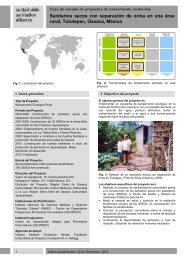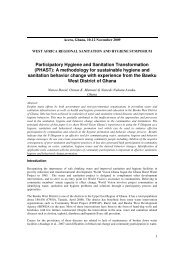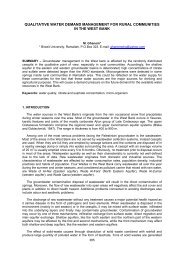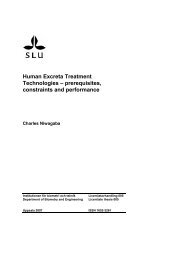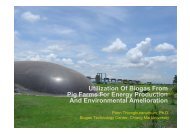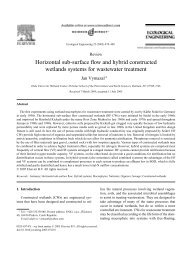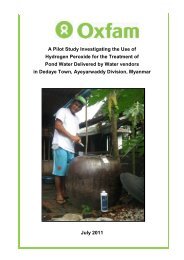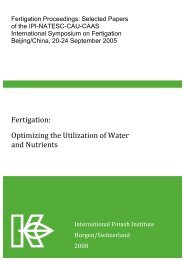Water conservation in textile industry - SSWM
Water conservation in textile industry - SSWM
Water conservation in textile industry - SSWM
Create successful ePaper yourself
Turn your PDF publications into a flip-book with our unique Google optimized e-Paper software.
Use of automatic shut-off valves<br />
An automatic shut-off valve set to time, level, or temperature<br />
controls the flow of water <strong>in</strong>to a process unit. One plant estimated<br />
that a reduction <strong>in</strong> water use of up to 20 percent could be<br />
achieved with thermally controlled shut-off valves.<br />
Use of flow control valves<br />
A flow or pressure-reduction valve can significantly reduce<br />
the quantity of water used <strong>in</strong> a wash or clean-up step. These<br />
valves are particularly useful <strong>in</strong> clean<strong>in</strong>g areas where operators are<br />
not always aware of the need for water <strong>conservation</strong>.<br />
Flocculation of clean water of pigment pr<strong>in</strong>t<strong>in</strong>g<br />
A rotary screen pr<strong>in</strong>ter uses as much water as a cont<strong>in</strong>uous<br />
wash<strong>in</strong>g range. All this water is used to wash the belt, to r<strong>in</strong>se the<br />
pipes and pumps and to clean the screens and squeegees. The<br />
water does not come <strong>in</strong> contact with the fabric. When only pigments<br />
are used for pr<strong>in</strong>t<strong>in</strong>g, it is relatively easy to coagulate the<br />
pigments and let them settle. The result is the clean water, which<br />
can be used for clean<strong>in</strong>g purposes.<br />
Use s<strong>in</strong>gle stage of process<strong>in</strong>g<br />
Knitted fabric process comb<strong>in</strong>ed bleach<strong>in</strong>g/scour<strong>in</strong>g and<br />
dye<strong>in</strong>g giv<strong>in</strong>g considerable sav<strong>in</strong>g <strong>in</strong> water. The scour<strong>in</strong>g and<br />
bleach<strong>in</strong>g process takes place for 10-20 m<strong>in</strong>utes and without<br />
dra<strong>in</strong><strong>in</strong>g the bath the dye<strong>in</strong>g is carried out without any loss of<br />
depth of colour value. In some cases the f<strong>in</strong>ish<strong>in</strong>g process can also<br />
be carried out along with the dye<strong>in</strong>g process.<br />
Use of low material to liquor ratio systems<br />
Different types of dye<strong>in</strong>g mach<strong>in</strong>ery use different amounts of<br />
water. Low liquor ratio dye<strong>in</strong>g mach<strong>in</strong>es conserve water as well as<br />
chemicals and also achieve higher fixation efficiency but the<br />
wash<strong>in</strong>g efficiency of some types of low liquor ratio dye<strong>in</strong>g<br />
mach<strong>in</strong>es, such as jigs, is <strong>in</strong>herently poor; therefore, a correlation<br />
between liquor ratio and total water use is not always exact.<br />
Typical liquor ratios for various types of dye<strong>in</strong>g mach<strong>in</strong>es are<br />
given below:<br />
Table-5: Liquor ratio <strong>in</strong> different dye<strong>in</strong>g mach<strong>in</strong>es<br />
Dye<strong>in</strong>g<br />
mach<strong>in</strong>e<br />
Typical liquor ratio liquor/goods<br />
at time of dye application<br />
Cont<strong>in</strong>uous 1:1<br />
W<strong>in</strong>ch 15:1-40:1<br />
Jet 7:1-15:1<br />
Jig 5:1<br />
Beam 10:1<br />
Package 10:1<br />
Beck 17:1<br />
Stock 12:1<br />
Ske<strong>in</strong> 17:1<br />
<strong>Water</strong> <strong>conservation</strong> measures <strong>in</strong> dye<strong>in</strong>g equipment<br />
Wash<strong>in</strong>g and r<strong>in</strong>s<strong>in</strong>g are both important for reduc<strong>in</strong>g impurity<br />
levels <strong>in</strong> the fabric to pre-determ<strong>in</strong>ed levels. <strong>Water</strong> and wastewater<br />
treatment prices are <strong>in</strong>creas<strong>in</strong>g, the optimization of water<br />
use pays dividends. One possible option is to reduce r<strong>in</strong>se water<br />
use for lighter shades. Here are some successful water reduction<br />
projects <strong>in</strong> batch and cont<strong>in</strong>uous operations.<br />
W<strong>in</strong>ch Dye<strong>in</strong>g: Dropp<strong>in</strong>g the dye bath and avoid<strong>in</strong>g overflow<br />
r<strong>in</strong>s<strong>in</strong>g could reduce water consumption reduced by 25%.<br />
High and Low: Replac<strong>in</strong>g the overflow with Pressure jet<br />
dye<strong>in</strong>g batch wise r<strong>in</strong>s<strong>in</strong>g can cut water consumption by approximately<br />
50%.<br />
Beam Dye<strong>in</strong>g: About 60% of water prevent<strong>in</strong>g overflows<br />
dur<strong>in</strong>g soak<strong>in</strong>g and r<strong>in</strong>s<strong>in</strong>g may reduce consumption. Automatic<br />
controls proved to be quite economical with a payback period of<br />
about four months.<br />
Jig Dye<strong>in</strong>g: A wide range of reductions rang<strong>in</strong>g from 15% to<br />
79% is possible by switch<strong>in</strong>g from the practice of overflow to<br />
stepwise r<strong>in</strong>s<strong>in</strong>g. R<strong>in</strong>s<strong>in</strong>g us<strong>in</strong>g a spray technique is also effective.<br />
Cheese Dye<strong>in</strong>g: A reduction of around 70% is possible follow<strong>in</strong>g<br />
<strong>in</strong>termittent r<strong>in</strong>s<strong>in</strong>g.<br />
Cont<strong>in</strong>uous Operation: A 20%-30% sav<strong>in</strong>g was realized by<br />
<strong>in</strong>troduc<strong>in</strong>g automatic water stops. Counter-current wash<strong>in</strong>g<br />
proved to be the most effective method. Horizontal wash<strong>in</strong>g<br />
equipment delivered the same performance as two vertical wash<strong>in</strong>g<br />
mach<strong>in</strong>es, us<strong>in</strong>g the same amount of water.<br />
References<br />
1. Bergenthal, J.F. “Wastewater recycle and reuse potential for<br />
<strong>in</strong>direct discharge <strong>textile</strong> f<strong>in</strong>ish<strong>in</strong>g mills”: Volume 1-Technical<br />
Report. U.S. Environmental Protection Agency.<br />
2. Waste reduction fact sheet, “<strong>Water</strong> <strong>conservation</strong> for <strong>textile</strong><br />
mills <strong>in</strong>dustrial pollution prevention program”. May 1993,<br />
NC division of pollution prevention and environmental assistance.<br />
3. NIIR Board, The complete technology book on “Textile process<strong>in</strong>g<br />
with effluents treatment”, Asia pacific bus<strong>in</strong>ess press<br />
Inc. I.S.B.N: 81-7833-050-4.<br />
4. Dr. Brent Smith, James Rucker, “<strong>Water</strong> and <strong>textile</strong> wet process<strong>in</strong>g,<br />
Part 1”, NCSU, Raleigh, NC.<br />
5. Edward Menezes, “Development <strong>in</strong> water treatment methods”,<br />
Pakistan Textile Journal, September 2003.<br />
6. Brown & Caldwell, “Industrial water <strong>conservation</strong> references<br />
of <strong>textile</strong> manufacturers and dyers”, California department of<br />
water resources.<br />
7. Environmental pollution control: “Textile process<strong>in</strong>g <strong>in</strong>dustry”,<br />
C<strong>in</strong>c<strong>in</strong>nati, OH: U.S. Environmental Protection Agency.<br />
8. Anton Luiken, Janet Mens<strong>in</strong>k, Lecture at the APTPMA sem<strong>in</strong>ar<br />
on “Environmental aspects of <strong>textile</strong> wet process<strong>in</strong>g”,<br />
2000.<br />
9. Jeffery D. Denit, Anne M. Gorsuch, Richard E. Williams,<br />
“Effluent limitations guidel<strong>in</strong>es and standards for the <strong>textile</strong><br />
mills po<strong>in</strong>t source category”, U.S. Environmental Protection<br />
Agency Wash<strong>in</strong>gton, D.C.<br />
10. Manual, “Better environmental management practices <strong>in</strong><br />
<strong>textile</strong> process<strong>in</strong>g sector”, World Wide Fund for Nature-<br />
Pakistan (WWF-P).<br />
11. Report 5, “Waste m<strong>in</strong>imisation and best practice”, The British<br />
Textile Technology Group, Ref: S5471, November 1999.<br />
12. Ms. Ilse Hendrickx, Gregory D. Boardman, “Pollution prevention<br />
studies <strong>in</strong> the <strong>textile</strong> Wet process<strong>in</strong>g <strong>in</strong>dustry”, 1995. Department<br />
of environmental quality office of pollution prevention.<br />
PTJ November 2009 51



